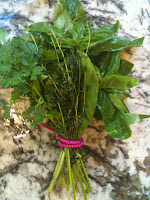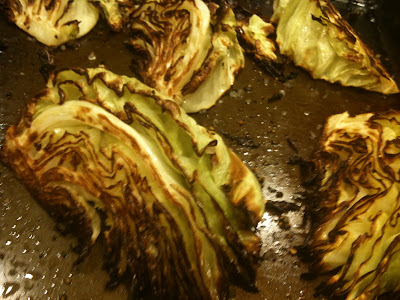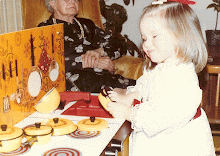So, we officially have a kindergartner in my house. We are now part of that world of busy, rushed mornings in which you have about 28 minutes to feed two children a healthy, hearty breakfast; dress one child while reminding the other to dress herself; put finishing touches on two lunchboxes and zip them into two backpacks; beg two children to put on the shoes you have so thoughtfully laid out for them; brush and style one child's hair while she whines; thank heaven that child #2 is a boy who's hair requires zero attention; hand out two toothpasted toothbrushes and hope that they manage to brush at least 50% of their teeth; help zipper and button two jackets; and, finally, buckle two children into carseats, load two backpacks into the backseat, and give up on getting the dog out of the front seat.
Suffice it to say, gone are our golden, slow-mo mornings when we luxuriated in breakfasts of homemade waffles and freshly whipped cream. We're off to the races, these days. But as my fellow mothers will note, the very first task on my above list is to feed two children a healthy, hearty breakfast. So the new criteria for breakfast are: (1) is it wholesome and healthful?; (2) will both my kids eat it?; (3) can I get it on the table in under two minutes? And despite what you may think, pancakes do fit the bill. Here's how:
(1) Wholesome? Healthful? These pancakes are made with organic whole wheat, flax seed, and pureed sweet potato (or pumpkin).
(2) Kid-pleasing? Aside from the healthy stuff, these pancakes have mini chocolate chips AND get drizzled in pure maple syrup. For extra credit, make the pancakes in fun shapes.
 (3) Super-fast? Now, here's the trick. To get from-scratch pancakes on the table in under two minutes, I make a HUGE batch on the weekend and then freeze them. Thirty seconds in the microwave (or pop in a toaster oven), and voila. Instant pancakes. I'm not going to lie to you and claim that they taste just as good out of the freezer. They don't. The texture suffers a bit. But my kids seem perfectly happy with them.
(3) Super-fast? Now, here's the trick. To get from-scratch pancakes on the table in under two minutes, I make a HUGE batch on the weekend and then freeze them. Thirty seconds in the microwave (or pop in a toaster oven), and voila. Instant pancakes. I'm not going to lie to you and claim that they taste just as good out of the freezer. They don't. The texture suffers a bit. But my kids seem perfectly happy with them.Here is my recipe for Chocolate Chip Pancakes. Well, Whole Wheat, Flax Seed, Sweet Potato, Chocolate Chip Pancakes. Depending on how picky your little ones are, you can choose how much of that title to share.
•1 c. flour
•1 c. whole wheat flour
•1/2 c flax seed meal
•2 TBSP sugar
•4 tsp baking powder
•1 tsp salt
•1 tsp cinnamon or pumpkin pie spice
•2 c. milk
•2 eggs
•1 c. pureed sweet potatoes or pumpkin (can get organic purees in cans or can steam and puree your own)
•1/4 c. butter
•handful of mini chocolate chips (about 1/5 of the bag)
1. Whisk all dry ingredients (flour through spice) in a large bowl. Make a large well in the center.
2. Melt the butter in a 2-cup glass measure and allow to cool a bit. Separate the eggs, adding the yolk to the melted butter and the white to the well in the center of the dry ingredients. Beat the egg yolks into the butter. Beat the egg whites in the well, then add the other wet ingredients, including the butter mixture. Mix all wet ingredients together, trying not to incorporate any dry ingredients yet. (This is my lazy way of not diryting another bowl by separately mixing the wet ingredients. I find it easiest to put in half the milk at first, stir it all up, then stir in the remaining milk.)
3. Mix the wet and dry together, using just a few strokes to moisten the flour. Add the chocolate chips and give it a few more stirs. It will be a very thick batter.
4. Spray and heat a large frying pan (or griddle) over medium to med-high heat. Don’t use too high a heat – pancakes will burn before cooking through.
5. When the pan is hot, spoon on the batter. I measure out about a 1/4 cup per pancake and, due to the thickness of the batter, I use the back of my spoon to help shape them a bit. Don’t crowd the pan or they’ll be hard to turn.
6. Turn when the rims are full of broken bubbles and the center is starting to bubble (about 2 mins.). Try to turn only once. The second side won’t take as long.
TO FREEZE: I have tried a couple different methods. Undoubtedly, the best was to let them cool on the counter, lay them in a single layer on cookie sheets, freeze solid, then transfer to freezer bags. They did not stick together at all this way. But it was so time-consuming that I barely ever do it that way. Instead, I used to let them cool on the counter, then put them into freezer bags with wax paper between the layers. This mostly kept them from sticking. Nowadays, I take the laziest possible approach: after cooling on the counter, I just pop them right into the freezer bag, on top of each other. Most of the time, they don't stick together too much -- I can just pop them apart -- but even when they do stick, I just break off two stuck together, then. By the time my kids see them, all cut up on their plate, they have no idea that the pancakes were less than pretty when they came out of the freezer.
TO MAKE SHAPES: Aside from the standard round pancake, you can easily make a "Mickey Mouse" (two small and one bigger circle) and "Snowman" (one small and one bigger circle). A heart is fairly easy, too. If you want to get advanced, there are very cool pancake molds out there. My only complaint about the molds is that, no matter how much I spray them, the batter tends to stick in any tight spots. So my advice would be to look for large shapes -- our heart and flower are much easier than our truck and airplane, e.g. And my sister gave me a "pancake pen" last Christmas. It's pretty amazing -- I can do letters, dinosaurs, cars, horses, etc. One caveat: if you're planning to freeze, the shaped pancakes break apart much easier than the sturdy round ones. So I just make enough shapes to feed them for the first breakfast, then make all rounds to freeze.











































